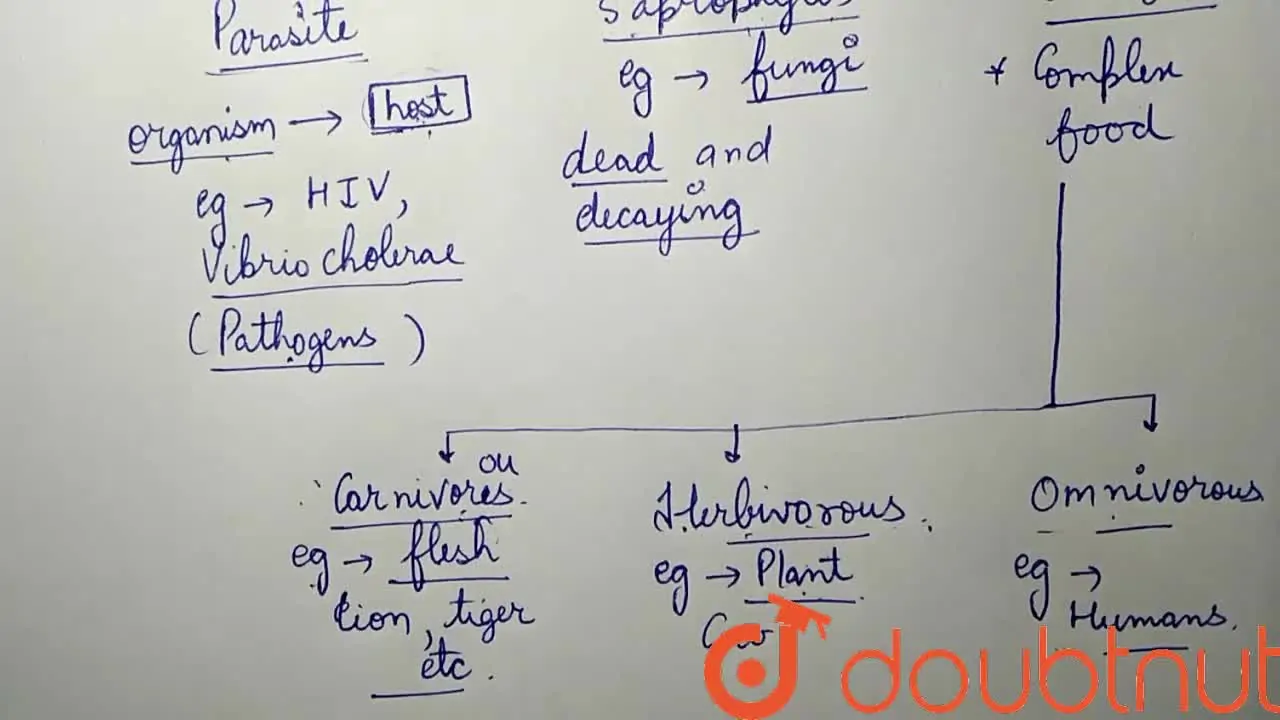Describe various strategies of heterotrophic nutrition.
Video Solution
Text Solution
Heterotrophic nutrition is a mode of nutrition in which organisms obtain ready made organic food from outside sources. The organisms depend upon out side sources. The organisms that depend upon out side sources for obtaining organic nutrients are called heterotrophs. It is a characteristic feature of all animals and non-green plants, that are unable to utilize carbon and synthesis organic compounds necessary for life, but depends upon organic sources of carbon. They are thus dependent upon autotrophic organisms (Plants) and are called as heterotrophs. It is of the following types:
(i) Saprophytic nutrition. In this type of nutrition, an organism lives upon dead organic sources such as dead plants and dead animals. These usually secrete dissolving and digesting enzymes and absorb the liquefied molecules so formed e.g. yeast, bread moulds and dung moulds etc.
(ii) Parasitic nutrition. In this type of nutrition, an organism lives totally at the expense of others and derives its food material and shelter from the other.
These organisms which derive food material are called parasites and the organisms from which food is derived is called as host. This type of nutrition is termed as parasitic or holozoic nutrition. It is also known as parasite-host relationship e.g. Cuscuta, Ascaris etc.
(iii) Holozoic nutrition. It is a mode of heterotrophic nutrition which invovles intake of solid pieces of food. Since solid food is taken in, Holozoic nutrition is also called ingestive nutrition. Holozoic nutrition (GK. "Holo".Whole, "Zoon"-Animal) is found in animals and protists. The food may consist of another animals, plant or its parts. Depending upon the source of food, holozoic organisms are of three types:
(a) Herbivores : These organism obtain their food from plants e.g. cow, rat, deer and goat etc.
(b) Carnivores : These organism take the flesh of other organisms as their food e.g. tiger, cheetah, snake, eagle, etc.
(c) Omnivores: These can feed on plants and flesh of other organisms e.g. human, cockroach, crow, etc.
|
Updated on:21/07/2023
Related Playlists
- BOOK - MBD -HARYANA BOARDCHAPTER - LIFE PROCESSESEXERCISE - SHORT ANSWER TYPE QUESTION25videos
LIFE PROCESSES
- BOOK - MBD -HARYANA BOARDCHAPTER - LIFE PRCOCESS (NUTRIENT, RESPIRATION, TRANSPIRATION AND EXCERTIONEXERCISE - EXAMPLE183videos
LIFE PRCOCESS (NUTRIENT, RESPIRATION, TRANSPIRATION AND EXCERTION
- BOOK - MBD -HARYANA BOARDCHAPTER - MANAGKHOENT OF NATURAL RESOURCESEXERCISE - EXAMPLE117videos
MANAGKHOENT OF NATURAL RESOURCES
Similar Questions
What is heterotrophic nutrition ?
View SolutionDefine the Heterotrophic nutrition
View SolutionDescribe various categories of dieases.
View SolutionDescribe various sources of water.
View Solution(a) Define a nutrient. Name four important nutrients persent in our food.
(b) What are the various types of heterotrophic nutrition ?View SolutionDescribe different types of heterotrophic nurtirtion . How do they differ from each other and from autotrophic nutrition ?
View SolutionDescribe various Intra-Uterine Devices
View SolutionIn fungi, heterotrophic nutrition may be
View SolutionIn fungi, heterotrophic nutrition may be
View SolutionDescribe various causes of water pollution.
View Solution


